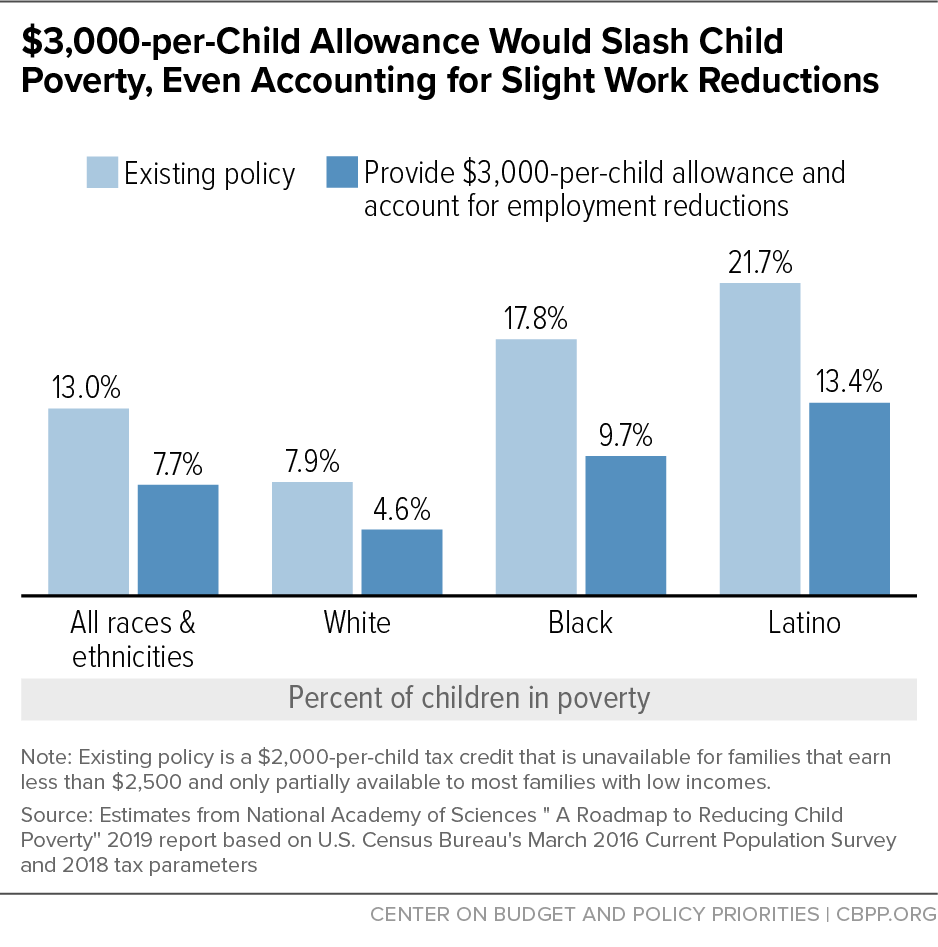Benefits of Expanding Child Tax Credit Outweigh Small Employment Effects
End Notes
[1] National Academies of Sciences, Engineering, and Medicine, A Roadmap to Reducing Child Poverty, National Academies Press, 2019, https://www.nap.edu/read/25246.
[2] Chuck Marr et al., “House Ways and Means COVID Relief Bill Includes Critical Expansions of Child Tax Credit and EITC,” Center on Budget and Policy Priorities, February 9, 2021, https://www.cbpp.org/research/federal-tax/house-ways-and-means-covid-relief-bill-includes-critical-expansions-of-child.
[3] National Academies of Sciences, Engineering, and Medicine, op. cit.
[4] Ibid.
[5] Irwin Garfinkel et al., “The Costs and Benefits of a Child Allowance,” Center on Poverty and Social Policy at Columbia University, February 18, 2021, https://www.povertycenter.columbia.edu/news-internal/2021/child-allowance/cost-benefit-analysis.
[6] Statistics Canada. Table 11-10-0135-01 Low income statistics by age, sex and economic family type. https://doi.org/10.25318/1110013501-eng.
[7] Harvard University Center for the Developing Child, “Connecting the Brain to the Rest of the Body,” https://46y5eh11fhgw3ve3ytpwxt9r-wpengine.netdna-ssl.com/wp-content/uploads/2020/06/InBrief-Connecting-the-Brain-to-the-Rest-of-the-Body.pdf.
[8] Uyen Sophie Nguyen, Sheila Smith, and Maribel R. Granja, “Young Children in Deep Poverty: Racial/Ethnic Disparities and Child Well-Being Compared to Other Income Groups,” National Center for Children in Poverty, October 2020, https://www.nccp.org/wp-content/uploads/2020/10/Deep-Poverty-Report-11.11.20_Final.pdf.
[9] Leila Morsy and Richard Rothstein, “Toxic stress and children’s outcomes: African American children growing up poor are at greater risk of disrupted physiological functioning and depressed academic achievement,” Economic Policy Institute, May 1, 2019, https://files.epi.org/pdf/164823.pdf.
[10] Harvard University Center for the Developing Child, “How Racism Can Affect Child Development,” https://developingchild.harvard.edu/resources/racism-and-ecd/.
[11] Danilo Trisi and Matt Saenz, “Economic Security Programs Reduce Overall Poverty, Racial and Ethnic Inequities,” Center on Budget and Policy Priorities, January 28, 2021, https://www.cbpp.org/research/poverty-and-inequality/economic-security-programs-reduce-overall-poverty-racial-and-ethnic.
[12] Chad Stone and Matt Saenz, “Labor Market Weaker Than Headline Numbers Suggest,” Center on Budget and Policy Priorities, March 1, 2021, https://www.cbpp.org/research/economy/labor-market-weaker-than-headline-numbers-suggest.
[13] Claire Zippel and Arloc Sherman, “Bolstering Family Income Is Essential to Helping Children Emerge Successfully From the Current Crisis,” Center on Budget and Policy Priorities, updated February 25, 2021, https://www.cbpp.org/research/poverty-and-inequality/bolstering-family-income-is-essential-to-helping-children-emerge.
[14] Ibid.
[15] Ibid.
[16] The NAS report estimates that 25.487 million people in families below 200 percent of the Supplemental Poverty Measure would be employed after the enactment of a $3,000-per-child allowance. That compares to 25.607 million people employed in such families under existing policy. The NAS report estimates that 4.552 million people in families below 200 percent of the Supplemental Poverty Measure would opt to work fewer hours, thereby decreasing their earnings. For these figures, see “CA Main Sheet” tab in Appendix E: TRIM3 Summary Tables found here: https://www.nap.edu/catalog/25246/a-roadmap-to-reducing-child-poverty#resources. Below 200 percent of the Supplemental Poverty Measure is roughly equivalent to the lower half of the disposable income distribution.
[17] The NAS report estimates that the enactment of a $3,000-per-child allowance would result in 277.4 million fewer hours worked, economy-wide. (See Table CA-2, p. 546.) That reduction in hours is spread over 6.079 million people of all incomes who are predicted to work fewer hours and therefore decrease their earnings and 149,000 people who are predicted to stop working. (See Table CA-3, p. 548.) Those figures yield 44.5 fewer work hours per year for each worker or 0.9 fewer hours per week over the 52 weeks of the year. We find a similar result even if we focus on the 4.552 million people in families below 200 percent of the Supplemental Poverty Measure that the NAS report estimates would decrease their earnings and assume that all reductions in hours worked occur within that group. If we divide the 277.4 million hours by those workers, we find an average reduction of hours worked per person of 1.2 hours per week.
[18] Carolyn J. Heinrich, “Parents’ Employment and Children’s Wellbeing,” Future of Children, Vol. 24, No. 1, Spring 2014, https://files.eric.ed.gov/fulltext/EJ1029033.pdf; Heather Sandstrom, “Why Parents’ Nonstandard Work Schedules Matter for Children: Is It the Hours or the Instability?” Urban Institute, August 31, 2015, https://www.urban.org/urban-wire/why-parents-nonstandard-work-schedules-matter-children-it-hours-or-instability; Jianghong Li et al., “Parents’ Nonstandard Work Schedules and Child Well-Being: A Critical Review of the Literature,” Journal of Primary Prevention, Vol. 35, No. 1, 2013, https://link.springer.com/article/10.1007/s10935-013-0318-z.
[19] Ceci Connolly, “Many on Hill Claim Parentage of Plan on Child Tax Credits,” Washington Post, July 22, 1997, https://www.washingtonpost.com/archive/politics/1997/07/22/many-on-hill-claim-parentage-of-plan-for-child-tax-credits/454363f4-38dd-41c9-933a-03bc19f052ba/.
[20] CBPP analysis of March 2020 Current Population Survey. We define low- and moderate-income families as those below 200 percent of the Supplemental Poverty Measure, which is roughly equivalent to the lower half of the disposable income distribution.
[21] Sandstrom, op. cit.
[22] LaDonna Pavetti, “TANF Studies Show Work Requirement Proposals for Other Programs Would Harm Millions, Do Little to Increase Work,” Center on Budget and Policy Priorities, November 13, 2018, https://www.cbpp.o. rg/research/family-income-support/tanf-studies-show-work-requirement-proposals-for-other-programs.
[23] Kristin F. Butcher and Diane Whitmore Schanzenbach, “Most Workers in Low-Wage Labor Market Work Substantial Hours, in Volatile Jobs,” Center on Budget and Policy Priorities, July 24, 2018, https://www.cbpp.org/research/poverty-and-inequality/most-workers-in-low-wage-labor-market-work-substantial-hours-in.
[24] Ibid.
[25] Richard Rothstein, The Color of Law: A Forgotten History of How Our Government Segregated America, Liveright, 2017; U.S. Bureau of Labor Statistics (BLS), “Labor force characteristics by race and ethnicity, 2018,” BLS Report 1082, October 2019, https://www.bls.gov/opub/reports/race-and-ethnicity/2018/home.htm.
[26] Bureau of Labor Statistics, Supplemental data measuring the effects of the coronavirus (COVID-19) pandemic on the labor market, Table 5, https://www.bls.gov/cps/effects-of-the-coronavirus-covid-19-pandemic.htm.
[27] Bureau of Labor Statistics, Supplemental data measuring the effects of the coronavirus (COVID-19) pandemic on the labor market, Table 9, https://www.bls.gov/cps/effects-of-the-coronavirus-covid-19-pandemic.htm.
[28] CBPP analysis of March 2020 Current Population Survey.
[29] Elisa Minoff, “The Racist Roots of Work Requirements,” Center for the Study of Social Policy, February 2020, https://cssp.org/wp-content/uploads/2020/02/Racist-Roots-of-Work-Requirements-CSSP-1.pdf.
[30] Ali Safawi and LaDonna Pavetti, “Most Parents Leaving TANF Work, But in Low-Paying, Unstable Jobs, Recent Studies Find,” Center on Budget and Policy Priorities, November 19, 2020, https://www.cbpp.org/research/family-income-support/most-parents-leaving-tanf-work-but-in-low-paying-unstable-jobs-recent.
[31] Pavetti, op. cit.


